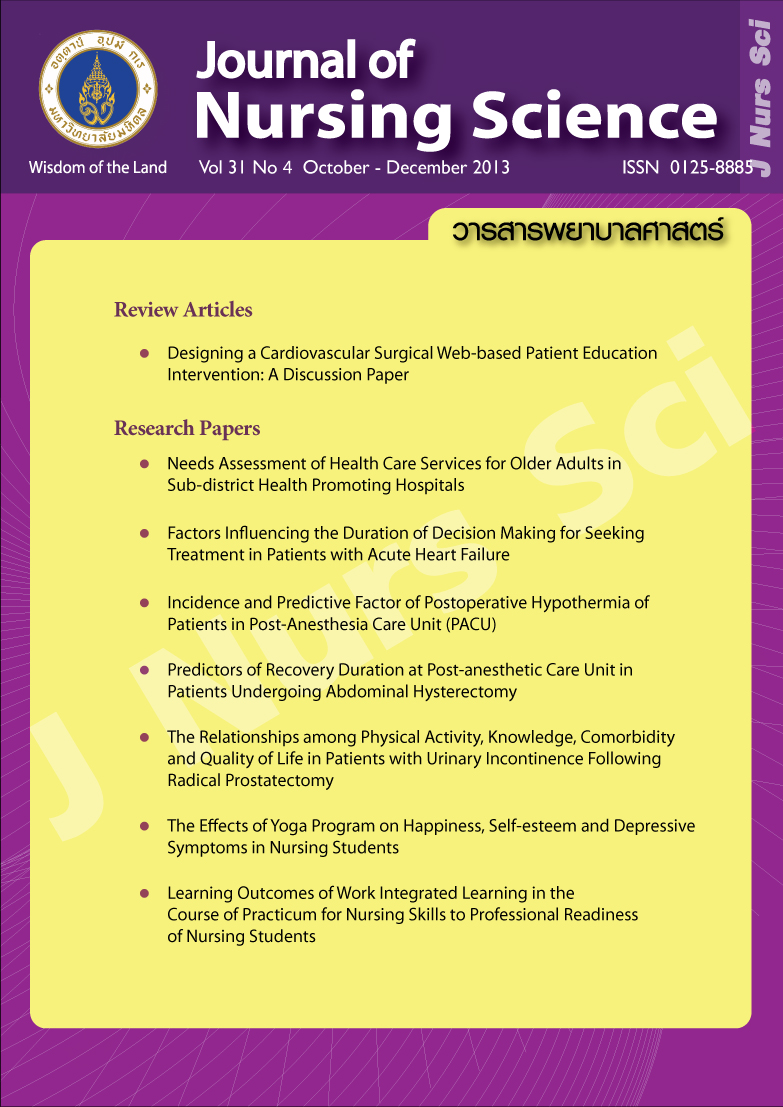Incidence and Predictive Factor of Postoperative Hypothermia of Patients in Post-Anesthesia Care Unit (PACU)
Main Article Content
Abstract
Purpose: This descriptive research was conducted to examine the incidence and predictive factor of postoperative hypothermia of patients in PACU.
Design: Correlational predictive design.
Methods: Subjects were 280 patients after surgery in PACU of Siriraj Hospital who met the inclusion criteria. The study was conducted between November 2010 and February 2011. Information was recorded in datasheet and the tympanic thermometer was used to measure core body temperature with infrared ray Brand Citizen CT 810. Its accuracy was validated and the precision was ± 0.1 °C. Data were analyzed using descriptive statistics and Binary Logistic Regression.
Main findings: This incidence of postoperative hypothermia was 45.4% (95% CI = 39.61%-51.23%). The highest incidence of postoperative hypothermia was found in patients 51-60 years old (56.5%). According to Binary Logistic Regression analysis, significant predictive factors of postoperative hypothermia were age, preoperative body temperature, use of warm blanket, abdominal irrigation and type of surgery.
Conclusion and recommendations: The predictive factors from this study can be used in nursing care to prevent hypothermia preoperatively and reduce the incidence of postoperative hypothermia in PACU.
อุบัติการณ์และปัจจัยทำนายการเกิดภาวะอุณหภูมิกายต่ำของผู้ป่วยหลังผ่าตัดในห้องพักฟื้น
ญาณนันท์ รัตนธีรวิเชียร, อุษาวดี อัศดรวิเศษ, นฤมล ทองคำ, กรรณิกา กัลยาณคุปต์
บทคัดย่อ
วัตถุประสงค์: เพื่อศึกษาอุบัติการณ์และปัจจัยทำนายการเกิดภาวะอุณหภูมิกายต่ำของผู้ป่วยหลังผ่าตัดในห้องพักฟื้น
รูปแบบการวิจัย: การศึกษาความสัมพันธ์เชิงทำนาย
วิธีดำเนินการวิจัย: กลุ่มตัวอย่างเป็นผู้ป่วยหลังผ่าตัดในห้องพักฟื้นของหน่วยพักรอดูอาการก่อนและหลังผ่าตัด โรงพยาบาลศิริราช ที่มีคุณสมบัติตามเกณฑ์ที่กำหนดจำนวน 280 ราย เก็บข้อมูลระหว่างเดือน พฤศจิกายน 2553 ถึง กุมภาพันธ์ 2554 เครื่องมือที่ใช้เป็นแบบบันทึกข้อมูล และเครื่องมือวัดอุณหภูมิทางช่องหู โดยใช้รังสีอินฟาเรด ยี่ห้อ Citizen รุ่น CT 810 ผ่านการตรวจสอบความเที่ยงและมีค่าความแม่นยำ ± 0.1 ํC วิเคราะห์ข้อมูลโดยใช้สถิติเชิงพรรณนาและการถดถอยโลจิสติกแบบทวิ (Binary Logistic Regression)
ผลการวิจัย: พบอุบัติการณ์ภาวะอุณหภูมิกายต่ำหลังผ่าตัดในห้องพักฟื้นร้อยละ 45.4 (95%CI = 39.61%-51.23%) พบมากที่สุดในกลุ่มที่มีอายุ 51-60 ปี (56.5%) ผลการวิเคราะห์การถดถอยโลจิสติกแบบทวิ พบว่า ปัจจัยทำนายการเกิดภาวะอุณหภูมิกายต่ำของผู้ป่วยหลังผ่าตัดในห้องพักฟื้น ได้แก่ อายุ อุณหภูมิกายก่อนเข้าห้องผ่าตัด การใช้เครื่องให้ความอบอุ่นร่างกาย การชะล้างอวัยวะในช่องท้อง และประเภทการผ่าตัด
สรุปและข้อเสนอแนะ: ปัจจัยทำนายจากการศึกษาครั้งนี้ สามารถนำไปใช้ในการวางแผนการพยาบาลเพื่อป้องกันภาวะอุณหภูมิกายต่ำได้ตั้งแต่ก่อนผ่าตัดเพื่อลดอุบัติการณ์การเกิดอุณหภูมิกายต่ำหลังผ่าตัดในห้องพักฟื้นต่อไป
คำสำคัญ: อุณหภูมิกายต่ำ ผู้ป่วยหลังผ่าตัด ห้องพักฟื้น
Article Details
Copyright Notice: Nursing Science Journal of Thailand has exclusive rights to publish and distribute the manuscript and all contents therein. Without the journal’s permission, the dissemination of the manuscript in another journal or online, and the reproduction of the manuscript for non-educational purpose are prohibited.

Disclaimer: The opinion expressed and figures provided in this journal, NSJT, are the sole responsibility of the authors. The editorial board bears no responsibility in this regard.


